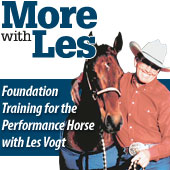 27th in a series
27th in a series
Last issue, Les reviewed the critical role of timing in the release. Now we pick up with vertical flexion, first at a standstill, then on a straight line.
Your first attempt at vertical flexion can be done at the standstill. In the video component of the program you’ll see me working with riders at a clinic to get their horses to drop their noses in response to my hand and leg collection aids. Once you’ve watched it, go try it with your horse.
After you’ve been getting vertical flexion on the bend and at the standstill for a while, introduce vertical flexion on a straight line as you walk your horse forward. This is a critical part of your ‘feel’ training, as you’ll be required to instantly adjust your pressure in one or both hands in order to teach your horse to maintain straight head-to-tail alignment while maintaining flexion at the poll.
Start by establishing light rein contact with both hands while you’re riding at the walk in a
straight line. Keeping that light feel, gradually squeeze your calves just behind the cinch (or
bump if you need to), driving your horse forward into the bit as you softly start to work the
bit back and forth with your fingertips, encouraging him to relax his poll and drop his head.
Ideally, you should feel your horse’s energy rise up through his back and soften down into your
hands. If instead you feel the horse leaning into your hands, you can speed up the right-left-right motion of your reins as you continue to drive with your legs but try to keep the overall feeling soft at this point in the game so you give your horse a chance to figure it out. As soon as he softens in the poll, release the rein pressure to reward him for his response. The quicker your hands respond when the horse responds, the faster his response will become a conditioned one and the less resistance you will get.
When you’ve been getting a soft response to the exercise above for about a week, ask your
horse to maintain a collected walk for a few more strides, then release and reward your horse
for the effort. Some riders find it helpful to let the horse make the decision of when their hands get active by establishing a head position that they like and to keep their hands pretty still until they feel the horse start to put pressure on the bit. Then they get to work and get the horse soft and in the bridle again. It teaches the horse that as long as he keeps his head where you put it, he’ll be left alone. But if he starts to lean on you at all, he’ll get in trouble. He can usually figure this out pretty quick.
From this point, you will continue to increase the amount of time you ask for collection and
eventually graduate to the jog and the lope. Keep in mind that moving this way is going to involve the use of muscles that may not be very developed yet in your horse. A little bit every day will allow him to get in shape to carry himself in this frame for longer and longer periods of time.
Training Tip
When a horse feels attacked or really scared, he’s going to remember it for life – as a prey animal that’s how they survive. In the wild, lions and wolves get a chance to try again if they miss, but when a horse slips up, that’s it for him – they’re survival depends on learing to avoid scary situations. By the same token, losing your temper one time, can have an indelible effect on your horse and his attitude about you. When he starts to feel like you’re going to ‘that place’ again, he’s going to react. He’s hard-wired that way.
EDITOR’S NOTE: More with Les is a regular California Horsetrader column. Les Vogt has won more than 15 World Championships, including two wins at the NRCHA Snaffle Bit Futurity. Although Les still rides and occasionally shows, his focus is giving clinics around the world and developing products for the performance horseman. To learn more about Les and to see his clinic schedule, visit: www.lesvogt.com
Leave a Comment
All fields must be filled in to leave a message.